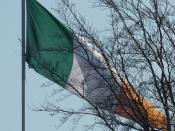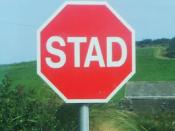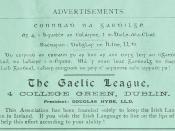In this article John Coolahan provides a detailed account of the realities and failure of imperial education through the Irish national school system and the control of Ireland on the whole. As a writer, Coolahan is renounced for his expert knowledge of the Irish educational system and recognised as an educational historian. The Irish Times (2009) describe him as "the Irish vision for education". His main research focuses include history of 19th and 20th century education systems, policies and comparative education. This paper can be seen as a more thorough and in-depth look at the national school system and its developments, in relation to imperialism. Whereas in one of his earlier writings, Irish education: its history and structure, he presents a broader account in terms of the National school system.
Coolahan gives the reader a brief insight as to just how long and how powerful their presence prior to the National school system, following the Act of Union (1801).
Ireland was ruled by the English for a long period of time, making it one of England's oldest colonies. In which the English, through the Tudor conquest aimed to create cultural and social assimilation between the two islands. This he identifies through the Act of parliament policy of Henry VIII, in which intended to promote 'a conformity, concordance and familiarity in language, tongue, in manners, ordeal and apparel.' The Act of Union (1801) conveyed a similar effort, if not a follow up of the former (Act of parliament). Seeing it was also guided by a policy to promote cultural and political assimilation, with the core agency being through the education system of the country. These efforts became more noticeable and applicable through the development of the Irish National school system, which Coolahan gives a clear and rounded picture of how the government carried this out.
The Irish National school system was established in 1831 under the direction of the Chief Secretary of Ireland, Lord Stanley. One if it's main objectives being to unite all children of all denominations under one educational system, with the allowance for separate religious instruction. Though, interestingly Coolahan points out that this was the aim from the viewpoint of Lord Stanley, in order to clarify to the reader that it was not recognised by all as being the main objective. This is identified though the way in which the paper addresses the National school system though a different perspective to the one in which was conveyed through the government's national policies and objectives. Coolahan demonstrates the governments' intention to use the National school system as a way to pass over complete control to the Board. In this paper, he describes the number of ways in which control was exercised and how these controls shaped the system. The Board controlled the teachers and their training, text-books used and most importantly the language of instruction used in Ireland. Coolahan argues that despite the National school system providing the Board with complete control in effort to implement the government's policy to create cultural assimilation. This new system aided by the state was growing immensely and becoming prominent, with 6,800 national schools consisting of a million pupils developing by 1870.
The Board controlled the teachers through early stage regulations by applying the previously used character profile, 'National teachers should be persons of Christian sentiment, of calm temper and discretion; they should be imbued with a spirit of peace, of obedience to the law, and of loyalty to their Sovereign...' Coolahan describes this as also being the same qualities which were wanted of the hedge school masters (scoileanna scairte). Teachers had to abstain from controversies, which would lead to disloyalty or subversion. However, with the strict regulations and inspections of teachers a number of events took place in which the result was dismissal. The Fenian Rebellion 1867, Manchester Martyrs and the Easter Rising 1916, were those in which Coolahan used to illustrate an image of the conflict arising from the control.
In his description of the Nation school text-books, he draws us a rich picture of what the reality of the control meant. Through the literature used in the curricular to the chants taught at the schools, Coolahan paints a very detailed image of the heavy influence of Anglicisation and the effects of imperialism on Ireland.
The Irish language was also a major aspect in which the Board excluded from the Nation school system. Throughout the article, this is where Coolahan particularly addresses the failures of the National school system. He not only acknowledges the denial of the Irish language, but also draws on a number of key figures and events that took place in trying to implement the Irish language. As, the efforts made to get the policy amended and the legitimisation of the Irish language within the schools were countless. It was made clear through the government's policy and the teaching in schools that the language of instruction would be English. In order for the promotion of the earlier policies, which the Imperial language and culture were to adopted for a cultural assimilation to take place. Therefore, the Board were adamant towards any changes being made to the policy. However, with the rise of individuals and nationalist movements, there was significant pressure being placed on the Commissioners to change their policy. One of those being, prominent leader, Thomas Davis who spoke out against the neglect of the Irish language and cultural heritage. Coolahan explains that although Davis was calling on the use of the Irish language he did not except the Irish language to be used in English-speaking regions or the eastern parts of the island. In a statement by Davis, of which he says: 'simply requiring that teachers of the national school in these Irish-speaking districts to know Irish, and supplying them with Irish translations of the school books would guard the language where it now exists, and prevent it from being swept by the English tongue, as the red Americans have been by the English race from New York to New Orleans. This illustrates the 'ethnic cleansing' taking place in Ireland, which Coolahan demonstrates throughout this paper unlike his previous work on Irish education. He also points out the dilemmas as a result of the language barrier for Irish Speakers, this was brought to attention of the Commissioners through annual reports in 1855, 1857 and 1858 submitted by Patrick Keenan (head inspector). As a result he made a suggestion to the problem, in which Irish should be implemented in Irish-speaking districts. They rejected the arguments made in favour of the language, but developed a payment-by-results policy in 1872. This made the situation worse than previously, Coolahan mentions that a number of literatures explain the affect on pupils, teachers and schools managers in the Irish-speaking districts. However, he does not source or reference these for the reader. Which is quite surprising as most of the paper is very detailed and outlines a cross perspective, even though the main paper conveys the failures of the National school system.
The establishment of the revivalist group, the Gaelic League in 1893, brought about more persistent criticisms towards the policy of the Commissioners. However, even though this had no major influence, yet they still continued to put pressure. This eventually saw the acceptance of a bilingual policy for National schools in the Irish-speaking districts. Eventually by 1906, the changes and the victory of implementing language in some areas were viewed as de-anglicisation to the previous effects of the Union. However, Coolahan demonstrates his passion in the heart of this imperialism through his understanding and doubt that the changes would be left at that.
Coolahan study on the National school system, provides a thoroughly detailed, as well as a well thought account of the actual effect of colonisation on Ireland. His excellent use of historical context, as well as detailed footnoting and a chronology of key events, including, policies and individuals/groups, provides an understanding on a wider scope to the Nation school plan. This work is very informative to historians, educationist and policy makers, covering the 19th century and 20th century history of Irish education.
BibliographyCoolahan, John, (1981), Irish Education: Its History and Structure, Dublin, Institute of Public Administration, DublinCoolahan, John, (1988) 'Imperialism and the Irish national school system', in Mangan, J A (Ed) The Irish National School System, Manchester Press, ManchesterThe Irish Times. (2009). The man who 'knows more than anyone about Irish education'. 6th Oct. Available at: http://www.irishtimes.com/newspaper/education/2009/1006/1224255972714.html [Accessed 1st December 2009].






